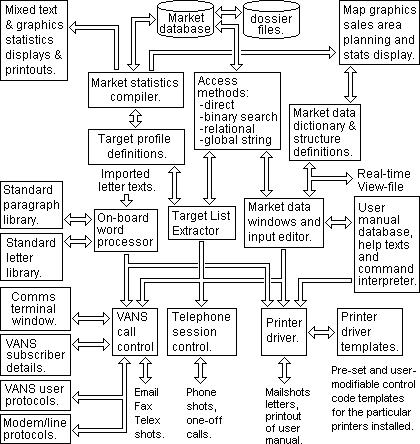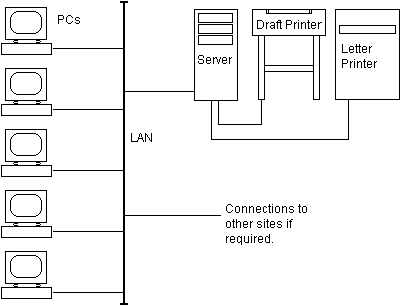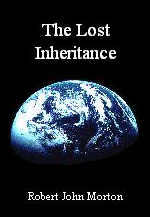From 1980 to 1990, I spent 15,000 hours developing a Marketing and Sales aid called Marketeer. An overview of its main functions and their interactions is shown below:

Marketeer was released first on an ITT 2020 (Apple II clone) in 1981. It was converted for the IBM PC/XT during 1985, and a multi-user network version was installed at its first user site in June 1986. It was a growing design which was continually being improved in the light of in-house research and suggestions from the field. It was written in Microsoft QuickBASIC. I once had the intention to re-write it as a Java applet to run within a browser window or on a Java-enabled operating system's desktop but saw the demise of the Java applet platform which occurred finally in 2019. I have subsequently [during 2020] written a completely re-vamped version of Marketeer in 'C' to run on Linux.
Marketeer provided its users with automated help to:
- define a framework for organising their market information
- maintain and retrieve details of established and prospective customers
- communicate with them through a combination of media
- provide a dynamic statistical view of how the market is shaping up.
The Database
The database maintains 4 types of information on contacts within a company's marketplace:
- A Name & Address Card
- A Keyed Market Profile
- A Date stamped Diary of Contact Events
- A Dossier file.
In order to meet the needs of marketing and sales people receiving incoming calls, an achieved design requirement was to be able to retrieve any customer record by any access route within 1½ seconds (including the time required for searching, loading, decrypting and displaying) with at least 15,000 records on the database.
Entry, retrieval and maintenance of individual records was done through the Market Data Windows. In addition to normal indexed access, a cross-reference indexing facility was included which allowed the user to link individual contacts' records into chained groups. A chained group may consist of contacts who have a given type of relationship between themselves as opposed to their individual relationships with the user company.
A hot-key facility was provided to swap the display back and forth between the Market Data Windows and a context-controlled on-line user manual window to provide easy self-tutoring for new users. This was in addition to context-controlled help screens. The manual could be printed out at any time in whole or in part. It was updated by diskette along with the software.
A viewing window was also provided which could pipe information in real-time from a file maintained dynamically by another package. This was useful for allowing sellers of fast-moving stock to see up-to-the-second stock levels so stock did not become committed to more than one customer.
Targeting
Marketeer's targeting facility allowed the user to specify a market profile (in terms of characteristics and attributes) of a subgroup of individuals or companies within his marketplace, and then extract from the main database a shortlist of the individuals and companies who fitted this market profile. These 'target' profiles could define a wide variety of group-types. For example, a target profile could specify such groups as:
- everybody whom we should telephone today
- everybody we should write to this week
- everybody who has attended a seminar within the last 'n' days
- everybody within the Yorkshire and North-Central sales areas
- everybody who is a prospect for a specified product-type
- everybody who is at an advanced stage towards a sale
- everybody within a range of specified SIC classes
- everybody meeting certain user-defined trade-specific criteria
or various combinations of these.
Having extracted such a shortlist, the user could view the records of those on the list and cull out any individuals he specifically wished to exclude. The members of a targeted shortlist could be presented in alphabetic order, postcode order, reference order, or various combinations of these. Any targeted shortlist could then be compiled as:
- a mailshot list
- a telephone session list
- an Email/telex/fax-shot list
for use by those respective subsystems.
Communications
Marketeer provided the user with several means of communicating with his market or customer base as follows:
Word Processing
Marketeer contained an on-board word processor specially written for producing sales and marketing letters. It provided a means of creating and maintaining a library of standard paragraphs. It also provided a means of creating and maintaining a separate letter library. Letters could either be written from scratch, or started off by copying-in selected standard paragraphs which could then be tailored and added to within the new letter. A variant of a standard letter could be produced by a duplication-and-edit feature which preserved the original letter.
The text of a letter was independent of its means of transmittal, so the decision as to whether it should be sent by post, email, telex or fax could be taken after it had been written. In fact, it could be sent by post and repeated to the same or another addressee by fax, telex or email later. Letters to be sent by post could be typeset fully justified or for printing in a proportional space typeface. Any finished letter text could be selected from the letter library as the current text to be use by the mail and communications subsystems for printing or transmission.
Mailing
The mailing subsystem could print one-off letters addressed to any contact retrieved individually from the market database, or an entire mailshot based on the currently selected letter text and the currently designated target list. Style of salutation and signing was determined automatically from information within each addressee's market database record. Full monitoring and control of a mailshot print run was maintained with facilities and procedures built in for coping with paper jams and temporary loss of printer access.
The mailing subsystem automatically 'ticked off' each addressee as his letter was printed, and updated his database event key and diary entry with the fact that this particular letter had been sent to him. A mailshot report could be printed once the mailshot had been completed. This gave a skeleton letter showing the letter text followed by a list of addressees to whom the letter had been sent.
Different types of printer could be used by Marketeer. This was made possible by a single printer driver which could be controlled by a printer control code template. Templates were provided for various printers, but the user could edit these to make use of added printer facilities as technology progressed.
Marketeer used two logical printers which could be the same physical printer if necessary. One logical printer was a draft quality printer for reports, and the other was a correspondence quality printer for printing letters. Modern printers such as the Hewlett-Packard DeskJet can fulfil both roles well, although in high throughput installations a separate matrix printer and laser printer would be preferable.
Email
The electronic mail, telex, fax subsystem was simply an electronic version of the mailing subsystem, except that the messages were produced in a 'telex or memo' style or format. A value-added network service [VANS] such as Mercury Link7500 was used as a store and forward facility so that operative's time was not wasted by busy subscriber terminals, and so that Marketeer could send the text to the type of terminal (email, telex, fax, etc) specified in the individual addressee's market database record.
It also meant that multi-users could send messages independently of each other using only their normal telephone extension lines: no need for individual telex or fax lines, or the necessary pre-segregation of recipient terminal types required by a server-based telex or fax dispatcher. Subscription and protocol details for several VANS could be maintained so subscribers to different VANS could be contacted.
A terminal window was attached to the communications subsystem which could be used to send letter texts manually, receive incoming messages and capture them in an incoming messages library for later viewing or printing, or to allow a marketing or sales operative to check out the credit worthiness of a new customer or prospect via one of the VAN services such as Infocheck.
Telephone
Marketeer's telephone subsystem could be used in two ways:
The market database could be used as a super telephone directory which read the called customer's telephone number directly from his on-screen name & address 'card' and dialled it automatically.
The currently-designated target list could be used to retrieve customer records in list-order, auto-dialling each customer in turn on command.
Both updated each called customer's market database record with the fact that a telephone call event had taken place and the date on which it was made. Before, during or after a call, the user was free to enter or amend the customer's name & address, telephone number, market profile, diary notes and dossier file.
The following relates to the second use: the telephone session. After each call attempt had been made the user had to select a 'call result' option as a measure of how useful the call was. Any call which failed was presented to the user again once the end of the list had been reached so that it could be retried as many times as was deemed expedient.
A telephone session could be broken at any time and continued later. At the end of a session when all calls that could be made had been made, a telephone session report could be printed giving the name and company of each called contact together with the time, date and result of each call. A summary of the numbers of calls with each possible outcome or result was given for session evaluation.
On multi-user installations, a facility was provided to allow one user to expedite a telephone session on behalf of another — e.g. for a telesales operative to phone on behalf of a rep who was currently on the road. The auto-dialling software maintained full control of the call, providing visual indication of digits being dialled, and prompting the user upon dialling completion.
The Data Dictionary
Customer market profiles were stored in the database as binary selections. These were interpreted for presentation through a data dictionary as plain English names or descriptions. The plain English names and descriptions were placed in the Data Dictionary when Marketeer was installed and are only updated infrequently and then only on management instruction.
When assigning a named or descriptive classification within the market profile of a specific individual contact or company, the user simply selected one (or more according to the nature of the key) of the name/description choices offered for that key. This minimised the wrong or non-categorisation of an individual or company due to the mis-keying of an indexed name or description.
Free-form textual descriptions could be entered elsewhere in an individual's or company's market database record.
Sales Area Map-Graphics
Marketeer's geographic key was based on the Postcode System. Sales areas were defined as the post areas they contained. Users defined or planned their sales areas on a Postcode Key map by marking them on the map. (A plastic laminated map was preferred for this purpose.) The two-letter post area codes were then placed in the data dictionary along with suitable sales area names. Provided each individual's or business's address were postcoded, their sales area would be determined automatically by the software, and would be automatically re-determined if sales areas were subsequently changed without any need to alter individual or company market database records. A sample sales area scheme based on the IBA television transmission areas was supplied with Marketeer.
The user-defined sales areas could be displayed on a map of the U.K. (with an expanded inset of London) from which the user could check that the postcodes had been entered correctly. Incorrect post area assignments appeared as disconnected fragments of sales areas in parts of the country where they should not be (although fragmented sales areas were perfectly valid if that were what was required). On the map graphics display was also provided a bar graph showing the percentage of all the people and companies on the market database who were located in each sales area. A bar showing the percentage of the U.K. 'population' (postal delivery addresses) in the same sales area was also displayed for comparison.
Market Statistics
Marketeer had a market database statistics compiler which counted the numbers of individuals and companies in the database holding each setting of each key within the market profile structure. It could perform the counts either on the database as a whole, or on only those individuals or companies who were members of a specific target group. These counts could then be presented as either tabular displays or as graphics bar charts. They could also be printed.
Import/Export
Marketeer included functions which imported and exported customer data into and out of its database. Export could be selective in that what was exported was a targeted list.
Database Integrity
Although they were continually improving, PC networks had not been completely fault-free since Marketeer was first implemented on a network in 1986. Network errors could be caused by such things as power supplies and people accidentally tripping over signal cables and disconnecting them. If a network error occurred at certain critical times it could corrupt a database.
Marketeer had a built-in function for reconstructing its database in such an event from 'redundant' or replicated data within its database. This facility never failed to regain full database integrity after a database corruption. A quicker facility was included simply for checking the integrity of the database if an event had occurred which could possibly have resulted in database corruption.
Encryption
All customer/prospect information within the market database and dossier files was encrypted. This ensured that information could not be obtained from the database by reading its files directly through a byte-picker or a word processor with an ASCII-literal view option.
Configuration
One copy of the Marketeer software could support up to 40 users (or up to 100 by special installation). Each unified Marketeer database could hold up to 32,767 customer records. One copy of the software could drive an unlimited number of independent databases subject to hard disk capacity.
Below is a typical equipment configuration for Marketeer in a marketing/sales office with 5 telemarketing/sales secretaries supporting 10 sales reps around the country. The Marketeer software and database are held on the server and marketing and sales data is accessed and maintained by the sales secretaries from their individual PCs connected to the local area network (LAN).

Almost as soon as I bought the ITT2020 (Apple II look-alike) in 1980, I wrote a word processor program for that machine which I called Author's Delight. It was not written for a client. It was a piece of in-house development I did entirely for myself.
Author's Delight was specifically designed for writing and presenting technical manuals and articles and was able to print camera-ready copy in a double column A4 house style in proportional space type with running headers and footers using an Olympia ESW103 typewriter. I translated Author's Delight for use on the IBM PC in 1985.
Author's Delight was truly a word processor: its logical field was a word; not a line. Its logical record was a paragraph and its logical file was a chapter. It regarded lines as the physical folding of a paragraph. It used a fixed-frame screen window to hold what was termed a physical paragraph.
This was quite different from the scrolling approach used by most modern word processors and stemmed for a difference in application. Most word processors are for typists and secretaries to produce neat letters and reports dictated or written long-hand by their originators. Author's Delight, on the other hand, was designed for a creative keyboarder who wishes to discipline himself to work on, and perfect, a single paragraph or thought-sequence at a time as a complete semantic building block of a document.
I used Author's delight to write the whole 400+ page user manual for my software package Marketeer in 1983-84. Author's Delight was also implemented as an on-line hot-keyed multi-tasked window within Marketeer itself.
Parent Document |
©Apr 1994 Robert John Morton


